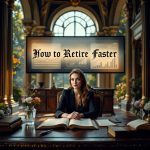
Which Is the Greatest Risk When Investing in Stocks? Crashes, Fear, or Foolishness
Dec 31, 2024
Introduction: Understanding the Risks of Stock Market Investment
Investing in stocks is a venture filled with both promise and peril. The omnipresent risk of market crashes, fear-driven decision-making, and human folly tempers the allure of significant returns. While much discourse revolves around market crashes, an astute investor must also consider the roles of fear and stupidity. Today, we will cover these three critical risks, exploring their historical context, psychological underpinnings, and implications for modern investors. By examining mass psychology, behavioural psychology, and technical analysis, we will uncover how these elements can be harnessed to mitigate risks and enhance investment strategies.
The Specter of Market Crashes: Historical Context and Implications
Market crashes are often the first risk investors consider. They are sudden, dramatic declines in stock prices, and their impact can be devastating. History is replete with examples, from the Tulip Mania of the 1630s to the Great Depression in 1929 and the 2008 Financial Crisis. These crashes often stem from speculative bubbles, economic missteps, and unforeseen events.
The 1929 crash, for instance, was precipitated by speculative excesses in the Roaring Twenties. As stock prices soared, investors borrowed heavily to buy more stocks, creating a fragile market susceptible to collapse. Once panic set in, the market plummeted, leading to a decade-long economic downturn.
According to economist John Kenneth Galbraith, such crashes reveal the “bezzle,” or the level of undisclosed financial misconduct, which becomes apparent only when the tide recedes. Thus, crashes expose underlying vulnerabilities in the economic system, often overlooked during boom periods.
Fear: The Invisible Hand Guiding Investor Behavior
While market crashes are conspicuous, fear operates more subtly yet pervasively. Fear can paralyze investors, leading them to sell stocks prematurely or avoid investing altogether. Behavioural psychology sheds light on this phenomenon, mainly through the concept of loss aversion. Daniel Kahneman and Amos Tversky’s Prospect Theory posits that individuals fear losses more than they value gains, prompting irrational decision-making.
Fear is not a new player in the finance world. As early as 2000 BC, traders in Mesopotamia faced anxiety about crop yields and trade routes. Modern investors are no different; the dot-com bubble burst in the early 2000s is a testament to the power of fear. As tech stocks began to falter, investors panicked, selling off shares in a race to the bottom.
Moreover, fear is contagious. Crowd psychology reveals how fear can spread like wildfire, creating self-fulfilling prophecies. Consider the 2008 Lehman Brothers collapse, which triggered widespread panic and a sell-off that deepened the financial crisis. Understanding fear’s pervasive influence can help investors recognize its role and circumvent decisions driven by anxiety rather than logic.
Stupidity: A Persistent Risk in Human Nature
Stupidity, or the tendency to make irrational decisions despite available information, is another significant risk in stock investing. This facet of human behaviour is often linked to overconfidence, herd mentality, and cognitive biases. Nobel laureate Richard Thaler highlights the “endowment effect,” where individuals overvalue what they own, leading to poor investment choices.
The South Sea Bubble of the 18th century exemplifies stupidity’s role in market dynamics. Enticed by the promise of immense profits, investors ignored red flags and poured money into the South Sea Company. The bubble’s burst left many in financial ruin, illustrating how irrational exuberance can cloud judgment.
Modern-day parallels exist, such as the GameStop saga of 2021, where social media-fueled hype drove stock prices to unsustainable heights. Despite clear signs of overvaluation, investors continued to buy, driven by greed and the fear of missing out.
The Role of Mass and Behavioral Psychology in Trading
Mass and behavioural psychology offer profound insights into investor behaviour and market dynamics. They reveal how emotions and cognitive biases can drive market trends. Understanding these psychological forces is crucial for investors who aim to navigate the complexities of the stock market effectively.
Mass Psychology: The Power of the Crowd
Mass psychology, often called crowd psychology, examines how individuals in large groups can exhibit irrational behaviour driven by emotion rather than reason. Gustave Le Bon explored this concept in his seminal work “The Crowd,” which highlights how group people lose their sense of individual responsibility and become susceptible to collective emotions and actions. This phenomenon is particularly evident in market bubbles, where herd mentality propels prices beyond their intrinsic value.
For instance, during the dot-com bubble of the late 1990s, investors collectively drove up the prices of technology stocks to unsustainable levels, fueled by the fear of missing out and the belief that the internet would revolutionize business. When reality failed to meet these inflated expectations, the bubble burst, leading to significant financial losses. This illustrates how mass psychology can lead to irrational exuberance, creating opportunities for contrarian investors who recognize the signs of a bubble and act accordingly.
Behavioural Psychology: Cognitive Biases and Decision-Making
Behavioural psychology delves into how cognitive biases influence individual decision-making processes. These biases often lead investors to make irrational choices, deviating from what would be considered logical or optimal. One such anchoring bias is when individuals fixate on initial information, such as a stock’s past performance, and fail to adjust their expectations based on new data.
Another common bias is loss aversion, which suggests that people experience the pain of losses more intensely than the pleasure of equivalent gains. This can lead investors to hold onto losing stocks for too long, hoping to recoup their losses or to sell winning stocks prematurely to lock in profits. Understanding these biases can empower investors to make more rational choices by recognizing and mitigating the influence of emotions on their decisions.
The Intersection of Mass and Behavioral Psychology
The interplay between mass and behavioural psychology is evident in how market trends develop and evolve. For example, during periods of market volatility, fear can spread rapidly among investors, leading to panic selling and exacerbating price declines. Conversely, greed can drive prices higher during bull markets as investors collectively chase returns, often ignoring underlying fundamentals.
Acknowledging the existence of these psychological forces helps investors better understand that markets are not always efficient or rational. This awareness allows them to identify when emotions like fear or greed result in oversold or overbought conditions, creating opportunities for contrarian trades. Successful investors often develop strategies that incorporate an understanding of mass and behavioural psychology, enabling them to anticipate market movements and make informed decisions based on a comprehensive analysis of market dynamics.
Technical Analysis: Bridging Psychology and Strategy
Technical analysis, the study of past market data to predict future trends, offers a strategy to navigate the risks of investing. It can help investors anticipate market movements by identifying patterns and trends. For instance, the head-and-shoulders pattern is a reliable indicator of trend reversals, assisting investors in timing their trades effectively.
Combining technical analysis with insights from mass psychology can enhance trading strategies. Consider the Relative Strength Index (RSI), which measures market momentum. When RSI levels indicate overbought conditions, aligning this with mass sentiment can inform selling decisions before a downturn.
A real-world example is the 1987 Black Monday crash. Savvy traders who combined technical indicators with sentiment analysis predicted the downturn and mitigated losses. This approach demonstrates how a nuanced understanding of market dynamics can lead to successful outcomes.
Conclusion: Navigating the Risks of Stock Investment
Investing in stocks entails navigating a landscape fraught with risks, from market crashes to insidious threats of fear and stupidity. By understanding these elements through history, psychology, and strategy, investors can better position themselves for success. Embracing technical analysis and acknowledging the psychological forces can lead to more informed, rational investment decisions.
In an ever-evolving market, the most significant risk may not lie in the external factors that capture headlines but in the internal battles waged within each investor’s mind. By cultivating awareness and discipline, investors can turn these risks into opportunities, fostering resilience in uncertainty. As history has shown, those who learn from past mistakes and adapt to new challenges are best equipped to thrive in the world of stock investment.













